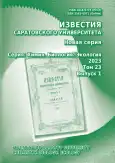The state of the environment in cities is determined by the degree of pollution of individual components of the environment. Geochemical anomalies in urban agglomerations are often formed in pollution depositing media such as soil, snow cover, bottom sediments. The purpose of the study is environmental monitoring of anthropogenic impact in diff erent areas of Smolensk and Vyazma according to the physical and chemical characteristics of melted snow. Snow was chosen as the object of the study, because it accumulates many substances entering the atmosphere, and subsequently can become a source of secondary pollution of the soil cover, underground and surface waters. The study determined organoleptic parameters (smell, color, turbidity, the presence of sediment in melt water), chemical parameters (the number of suspended particles, pH, total rigidity and mineralization, the amount of organic substances).The presence of chloride ions (Cl- ), sulfate ions (SO4 2-), nitrate ions (NO3-), nitrite ions (NO2 - ), bicarbonate ions (HCO3 - ) and ions of some heavy metals (Pb2+, Cu2+, Fe3+) have been determined. Bioindication of the studied samples on watercress has been carried out in parallel. A low level of air pollution in Smolensk and Vyazma has been established. The greatest contribution to the formation of the level of pollution in the cold period of the year is made by suspended substances, iron and manganese compounds in concentrations exceeding the maximum permissible concentration. The concentration of impurities depends on the distance from large industrial objects, automobile and railway objects, sanitary and technical condition and cleaning regime of the territory. The courtyard territories of Smolensk and Vyazma are the cleanest. The largest part of snow pollution is provided by the thermoelectric power stations and transport. Samples taken near car parks, railway tracks and near the thermoelectric power stations were the most unfavorable.
 4-10
4-10


 11-17
11-17


 18-27
18-27


 28-38
28-38


 39-50
39-50


 51-61
51-61


 62-69
62-69


 70-76
70-76


 77-85
77-85


 86-93
86-93


 94-103
94-103


 104-109
104-109


 110-123
110-123











